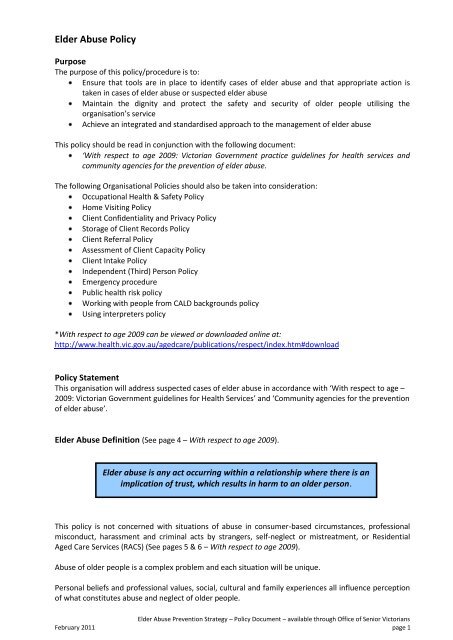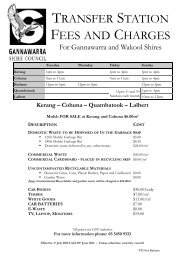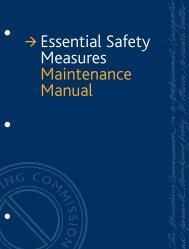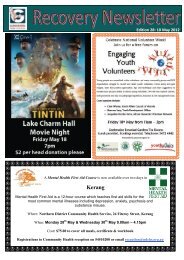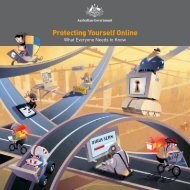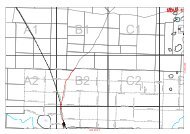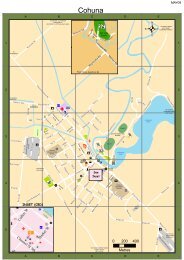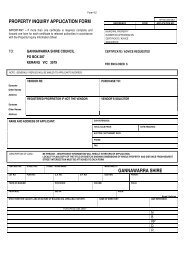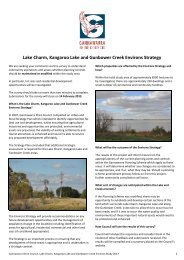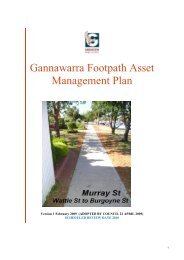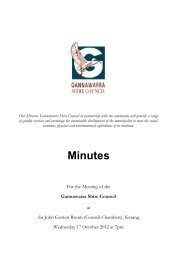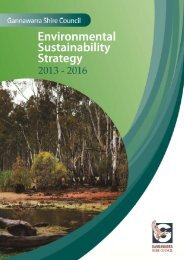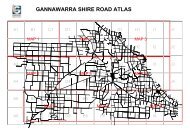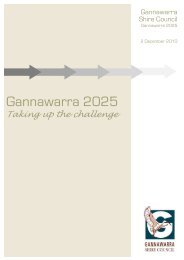Elder Abuse Policy - Gannawarra Shire Council
Elder Abuse Policy - Gannawarra Shire Council
Elder Abuse Policy - Gannawarra Shire Council
You also want an ePaper? Increase the reach of your titles
YUMPU automatically turns print PDFs into web optimized ePapers that Google loves.
<strong>Elder</strong> <strong>Abuse</strong> <strong>Policy</strong><br />
Purpose<br />
The purpose of this policy/procedure is to:<br />
Ensure that tools are in place to identify cases of elder abuse and that appropriate action is<br />
taken in cases of elder abuse or suspected elder abuse<br />
Maintain the dignity and protect the safety and security of older people utilising the<br />
organisation’s service<br />
Achieve an integrated and standardised approach to the management of elder abuse<br />
This policy should be read in conjunction with the following document:<br />
‘With respect to age 2009: Victorian Government practice guidelines for health services and<br />
community agencies for the prevention of elder abuse.<br />
The following Organisational Policies should also be taken into consideration:<br />
Occupational Health & Safety <strong>Policy</strong><br />
Home Visiting <strong>Policy</strong><br />
Client Confidentiality and Privacy <strong>Policy</strong><br />
Storage of Client Records <strong>Policy</strong><br />
Client Referral <strong>Policy</strong><br />
Assessment of Client Capacity <strong>Policy</strong><br />
Client Intake <strong>Policy</strong><br />
Independent (Third) Person <strong>Policy</strong><br />
Emergency procedure<br />
Public health risk policy<br />
Working with people from CALD backgrounds policy<br />
Using interpreters policy<br />
*With respect to age 2009 can be viewed or downloaded online at:<br />
http://www.health.vic.gov.au/agedcare/publications/respect/index.htm#download<br />
<strong>Policy</strong> Statement<br />
This organisation will address suspected cases of elder abuse in accordance with ‘With respect to age –<br />
2009: Victorian Government guidelines for Health Services’ and ‘Community agencies for the prevention<br />
of elder abuse’.<br />
<strong>Elder</strong> <strong>Abuse</strong> Definition (See page 4 – With respect to age 2009).<br />
<strong>Elder</strong> abuse is any act occurring within a relationship where there is an<br />
implication of trust, which results in harm to an older person.<br />
This policy is not concerned with situations of abuse in consumer-based circumstances, professional<br />
misconduct, harassment and criminal acts by strangers, self-neglect or mistreatment, or Residential<br />
Aged Care Services (RACS) (See pages 5 & 6 – With respect to age 2009).<br />
<strong>Abuse</strong> of older people is a complex problem and each situation will be unique.<br />
Personal beliefs and professional values, social, cultural and family experiences all influence perception<br />
of what constitutes abuse and neglect of older people.<br />
<strong>Elder</strong> <strong>Abuse</strong> Prevention Strategy – <strong>Policy</strong> Document – available through Office of Senior Victorians<br />
February 2011 page 1
Key principles underpinning the implementation of the Victorian Government<br />
<strong>Elder</strong> <strong>Abuse</strong> Prevention Strategy (See page 3 – With respect to age 2009)<br />
Competence - All adults are considered competent to make informed decisions unless<br />
demonstrated otherwise.<br />
Self Determination – With appropriate information and support, individuals should be<br />
encouraged to make their own decisions.<br />
Appropriate protection – where a person is not competent to make their own decisions, it<br />
may be necessary to appoint a guardian or administrator. If a person is represented, their<br />
wishes should still be taken into account as far as possible.<br />
Best Interests – The interests of an older person’s safety and wellbeing are paramount. Even<br />
when they are unable to make all decisions themselves, their views should be taken into<br />
account as far as possible.<br />
Importance of relationships – All responses to allegations of abuse should be respectful of<br />
the existing relationships that are considered important to the older person.<br />
Collaborative responses – Effective prevention and response requires a collaborative<br />
approach which recognises the complexity of the issue, and the skills and experience of<br />
appropriate services.<br />
Community responsibility - The most effective response is achieved when agencies work<br />
collaboratively and in partnership with the community.<br />
Duty of care (See page 99 – With respect to age 2009).<br />
A duty of care encompasses a duty not to be careless or negligent and arises from a relationship<br />
between parties that are regarded as sufficiently close as to infer that an obligation exists in some form.<br />
This relationship involves the notion of ‘proximity’ or a degree of closeness. Proximity is usually<br />
described in terms of time and (physical) ‘circumstantial casual’ relationship, such as the relationship<br />
between employer and employee, health worker and client.<br />
Duty of care involves a legal obligation to avoid causing harm or to prevent harm occurring to another<br />
person. This only arises where it is reasonably foreseeable in a particular situation that the other person<br />
would be harmed by an action or omission without the exercise of reasonable care. Health and aged<br />
care workers have a duty of care to older people they are assisting. Under the Wrongs Act 1958 (VIC) a<br />
worker is not negligent in failing to take precautions against a risk of harm unless:<br />
a) The risk was foreseeable (that is, it is a risk of which the person knew or ought to have known);<br />
and<br />
b) The risk was not insignificant; and<br />
c) In the circumstances, a reasonable person in the workers position would have taken those<br />
precautions.<br />
The duty of care obligation of an employee to foresee and prevent or avoid harm is limited by the<br />
employee’s professional expertise and competence.<br />
If a worker breaches their duty of care, they have failed to meet the expected standards of care. Duty<br />
of care not only refers to the actions of a worker but also to the advice the worker gives or fails to give.<br />
<strong>Elder</strong> <strong>Abuse</strong> Prevention Strategy – <strong>Policy</strong> Document – available through Office of Senior Victorians<br />
February 2011 page 2
Procedure if you suspect potential abuse<br />
Action taken will depend on the individual situation and will often involve a primary assessment team<br />
such as a Geriatrician, Doctor and Social Worker in conjunction with the person already involved with<br />
the situation of suspected abuse.<br />
1. Staff should report any suspicion of abuse to their supervisor. (See attachments 1 & 2 for<br />
information of types and signs of abuse and risk factors and attachment 3 for questions to assist<br />
with identifying abuse).<br />
2. If there is a concern that the older person does not have competence to make decisions, an<br />
appropriate referral to assess their capacity must be made. Assessment of an older person’s<br />
capacity to make decisions and informed choices is important. Their right to refuse support<br />
should be respected. An older person with mental capacity may be capable of managing their<br />
own affairs with minimal support from a health / community care worker. Mental capacity is<br />
the ability to understand an act, a decision or transaction and its consequence. A person has<br />
capacity to make an informed decision if they understand the general nature and effect of a<br />
particular decision or action and can weigh up the consequences of different options and<br />
communicate their decision. A person’s capacity to make a particular decision should only be<br />
doubted if there is a factual basis to doubt it (See pages 23 & 24 – With respect to age 2009).<br />
3. Most situations of elder abuse are not emergencies. If it is an emergency situation, staff should<br />
activate the organisation’s emergency procedure. An emergency is defined as a situation that<br />
poses an immediate threat to human life or a serious risk of physical harm or serious damage to<br />
property. Depending on the type and context of abuse, it may be useful to talk through the idea<br />
of planning an emergency response with the older person, should it ever need to be activated.<br />
In an emergency response, an older person should be involved in making decisions about their<br />
life as much as possible. However, if a worker assesses that an older person is in imminent<br />
danger of harm or death, it may be necessary to arrange the following:<br />
Support (for example, ambulance services)<br />
Medical treatment for an older person or carer (for example, referral to local doctor or<br />
hospital emergency department)<br />
Emergency accommodation for an older person or carer (for example, referral to<br />
supported housing services in the region, a women’s refuge or other temporary<br />
housing)<br />
Police involvement, which may be required for the safety of the worker as well as an<br />
older person<br />
An emergency application to VCAT (if the appointment of a temporary guardian is<br />
necessary, for instance, the Public Advocate) or a temporary administrator (for instance,<br />
State Trustees Limited) to protect an incompetent older person or their property and<br />
assets<br />
Other matters sensitive to cultural considerations, including religious beliefs, which<br />
ideally should be known prior to any emergency (See page 27 of With respect to age<br />
2009)<br />
4. Gather and document clear and relevant evidence of abuse (See page 36 – With respect to age<br />
2009 for more detail about documentation).<br />
5. Arrange for an assessment of needs of the older person, either in-house or refer to an<br />
appropriate funded assessment service (See page 23 – With respect to age 2009).<br />
6. Develop a care plan to support an older person to prevent further abuse. The care plan should<br />
include interventions to stop reoccurrence and may include a safety plan, developed in<br />
consultation with the older person. Set a review date, as the person’s situation evolves follow<br />
up on referrals and reviews should occur. Provide information about the older person’s rights<br />
and services available to assist, such as emergency services, local services, and state-wide<br />
services i.e. Seniors Rights Victoria (See page 31 – With respect to age 2009), local agency<br />
networks (LANs), and referral and interagency strategies.<br />
<strong>Elder</strong> <strong>Abuse</strong> Prevention Strategy – <strong>Policy</strong> Document – available through Office of Senior Victorians<br />
February 2011 page 3
Reluctance to accept intervention<br />
If an incompetent older person is at risk and refusing help (despite efforts made to persuade) it may be<br />
necessary to contact the older person’s substituted decision maker. For example, Medical Attorney<br />
under power or Guardian under power or apply to the Victorian Civil and Administrative Tribunal to<br />
appoint a temporary guardian to consent to support services or some other intervention.<br />
If an older person is competent but refuses help, a direct care worker can support and advise about<br />
options such as how to deal with emergencies. Strategies can then be developed to help the older<br />
person understand their rights, and feel confident and comfortable to take action.<br />
In a case of self-neglect in which a competent older person chooses to live in squalor, the situation<br />
could be considered as a public health risk under the Health Act.<br />
People with dementia and their carers<br />
People with dementia (Alzheimer’s or related disorders) may be at risk of financial neglect and selfneglect/abuse<br />
that includes actions of self-injury by the individual upon themselves which are passive or<br />
active.<br />
Carers of persons with dementia may require special attention where abuse or neglect is occurring, as<br />
they can be the recipients of verbal and physical abuse.<br />
People from Culturally and Linguistically Diverse (CALD) backgrounds<br />
Cultural factors influence how all forms of abuse are viewed, and specific strategies and responses to<br />
elder abuse should address such differences. Being culturally informed and providing sensitive support<br />
is an integral component of service provision. It is important that support is provided with an<br />
understanding of the cultural background.<br />
People from different cultural backgrounds may require interpreter services. Family and friends should<br />
not be used as an interpreter (See pages 9 & 10 – With respect to age 2009).<br />
Aboriginal and Torres Strait Islander People<br />
Advice should be sought from people experienced with the particular cultural background of the family<br />
concerned, acknowledging that cultural difference may require special sensitivity in relation to neglect<br />
and abuse (See pages 7 to 9 – With respect to age 2009 for more detail about Aboriginal and Torres<br />
Strait Islander People ).<br />
Confidentiality and Privacy<br />
Where possible, discuss with the person the concerns and gain permission to refer to other agencies. It<br />
is permissible to breach confidentiality in some very limited circumstances including where the older<br />
person has consented to the disclosure of information; where the law allows or requires the disclosure<br />
of confidential information; and, in extreme circumstances, where there is a clear and imminent threat<br />
to an identifiable person of serious bodily injury or death. (See pages 36 to 38 – With respect to age<br />
2009 for more information about privacy and confidentiality)<br />
<strong>Elder</strong> <strong>Abuse</strong> Prevention Strategy – <strong>Policy</strong> Document – available through Office of Senior Victorians<br />
February 2011 page 4
Attachment 1<br />
Types and Signs of <strong>Abuse</strong> (See pages 12 to 16 – With respect to age 2009)<br />
Physical <strong>Abuse</strong>:<br />
Behaviours that are physically abusive include:<br />
Pushing and shoving<br />
Kicking, punching, slapping, biting and burning<br />
Rough handling<br />
Restraining with rope, belts and ties<br />
Locking the person in a room, building or yard<br />
Using substance restraints including alcohol, prescribed and un-prescribed drugs, household<br />
chemicals, poisons<br />
Holding a pillow over a persons head<br />
Intentional injury with a weapon or object<br />
Signs of physical abuse may include:<br />
Internal injuries, unexplained bruises, pain on touching<br />
Bruises, lacerations, choke marks, abrasions or welts (ie evidence of hitting, punching, shaking,<br />
slapping or use of a weapon)<br />
Burns (ie.: ropes, cigarettes, matches, iron, hot water)<br />
Broken or healing bones<br />
Observed unexplained injuries or conditions such as paralysis, scalp injuries, scratches, sprains,<br />
punctures, unattended injuries, hypothermia, dehydration, pressure sores due to physical<br />
restraint<br />
Over sedation / under sedation<br />
Unexplained pain or restricted movements<br />
Cringing or acting fearfully<br />
Unexplained hair loss (perhaps from pulling), eye injuries, missing teeth<br />
Unexplained accidents<br />
Stories about injuries that conflict between the older person and others<br />
Financial <strong>Abuse</strong>:<br />
Behaviours that are financially abusive include:<br />
Threatening, coercing, putting undue pressure or forcing an older person into selling or handing<br />
over an asset . or property, or signing a document , wills or POA<br />
Abusing or neglecting POA to manage an older persons finances<br />
Stealing goods from an older person, i.e. jewellery, credit cards, cash, electronic equipment,<br />
blankets or food<br />
Using an older persons banking and financial documents without authorization<br />
Managing the finances of a competent older person without permission)<br />
Misuse of an older person’s possessions or money or possessions (e.g. vehicle, phone, internet<br />
connection<br />
Taking an older person to a general practitioner other than their own, for an assessment of<br />
decision-making capacity, in order to access an EPOA, particularly if the doctor speaks a<br />
language different from the older person<br />
Appropriating the proceeds of the sale of an older person’s home with the promise of providing<br />
future accommodation or care and then not providing it.<br />
Pressuring an older person to relinquish (hand over ) an anticipated inheritance or for a gift or a<br />
loan<br />
Incurring bills for which an older person is responsible<br />
<strong>Elder</strong> <strong>Abuse</strong> Prevention Strategy – <strong>Policy</strong> Document – available through Office of Senior Victorians<br />
February 2011 page 5
Signs of financial abuse may include:<br />
Missing belongings<br />
The inability of an older person to access adequate food, shelter or utilities<br />
Unfamiliar or new signatures on cheques and documents<br />
The inability of an older person to access bank accounts or statements<br />
The inability to pay normal accounts and the presence of unpaid bills<br />
Significant withdrawals<br />
A decline in the older persons spending habits<br />
Fear, stress and anxiety expressed by an older person<br />
Transfer of assets in circumstances where the person may no longer be sufficiently competent<br />
to manage<br />
Pressuring an older person to provide a deposit, or large investment into a property in return<br />
for accommodation and care, without sufficient protection and legal advice for the older person<br />
Threatening loss of an asset, e.g. family home if the older person does not contribute to<br />
mortgage, repairs or debts<br />
Psychological or emotional abuse:<br />
Behaviours that are psychologically or emotionally abusive include:<br />
Pressuring, intimidating or bullying<br />
Name calling, degrading, humiliating or treating the person like a child, in private or public<br />
Threatening to harm the person, other people, or pets<br />
Verbally or physically abusing an older person<br />
Preventing an older person from speaking<br />
Talking about not being able to cope as a carer<br />
Repeatedly telling an older person that they have dementia<br />
Threatening to withdraw affection or access to grandchildren or other loved ones<br />
Threatening to put an older person into a nursing home<br />
Emotionally harming (blackmail) via threatening remarks, insults or harsh commands<br />
Preventing access to services<br />
Signs of psychological / emotional abuse may include:<br />
Resignation, shame<br />
Depression, tearfulness<br />
Confusion and social isolation<br />
Feelings of helplessness<br />
Unexplained paranoia<br />
Excessive fear<br />
Insomnia<br />
Marked passivity or anger<br />
Neglect:<br />
Behaviours that are actively or passively neglectful include:<br />
Failure to provide the necessities of life, such as food, warmth and shelter or blocking others<br />
from providing basic needs<br />
Receiving the carers allowance and not providing care to an older person for whom one has a<br />
responsibility<br />
Active neglect is the intentional withholding of clothing, food, personal or health care and<br />
leaving the older adult in an unsafe place or in isolation, this includes misuse of medications and<br />
prescriptions including withholding and over medicating<br />
Passive neglect occurs when the caregiver unintentionally does not provide necessities because<br />
of lack of information, skill or interest<br />
Self neglect which is not a life long pattern and reflects a change in cognition<br />
<strong>Elder</strong> <strong>Abuse</strong> Prevention Strategy – <strong>Policy</strong> Document – available through Office of Senior Victorians<br />
February 2011 page 6
Signs of neglect may include:<br />
Inadequate nutrition, accommodation, clothing, medical or dental care<br />
Poor personal hygiene<br />
Poor skin integrity<br />
Exposure to unsafe, unhealthy, unsanitary conditions<br />
Malnourishment and unexplained weight loss<br />
Hypothermia or overheating<br />
Inappropriate clothing for the season<br />
The person left alone, abandoned or unattended for long periods<br />
Lack of social, cultural, intellectual or physical stimulation<br />
Injuries that have not been properly cared for<br />
Carer displaying overly attentive behaviour in the company of others<br />
Under medication or over medication<br />
Social abuse:<br />
Behaviours that are socially abusive include:<br />
Preventing contact with family and friends<br />
Withholding mail<br />
Not allowing the older person to use the phone or monitoring their phone calls or disconnecting<br />
the phone without consent<br />
Living in and taking control over an older person’s home without their consent<br />
Preventing an older person from engaging in religious or cultural practices including preventing<br />
those from CALD backgrounds from meeting their cultural needs<br />
Moving an older person far away from the immediate family or friends<br />
Preventing an older person from engaging in Aboriginal cultural practices if they identify as<br />
Indigenous<br />
Signs of social abuse may include:<br />
Sadness or grief at the loss of interactions with others<br />
Withdrawal or listlessness due to people not visiting<br />
Changes in levels of self-esteem<br />
Worry or anxiety after a particular visit by specific person<br />
Appearing ashamed<br />
Sexual abuse:<br />
Behaviours that are sexually abusive are:<br />
Non-consensual sexual contact, language or exploitative behaviour<br />
Touching an older person inappropriately or molestation<br />
Sexual assault<br />
Cleaning or treating the older person’s genital area roughly or inappropriately<br />
Viewing obscene video’s or making obscene phone calls in the presence of an older person<br />
without their consent<br />
Signs of sexual abuse may include:<br />
Unexplained sexually transmitted disease (STD)<br />
Recent incontinence (bladder or bowel)<br />
Internal injuries<br />
Human bite marks<br />
Scratches, bruises, pain on touching, choke marks on throat, burn marks<br />
Injury to face, neck, chest, abdomen, thighs or buttocks<br />
Trauma including bleeding around the genitals, chest, rectum or mouth<br />
Torn or bloody underclothing or bedding<br />
Anxiety when near or contact suggested with the alleged perpetrator<br />
Changes in sleep patterns, sleep disturbance or nightmares<br />
Attachment 2<br />
<strong>Elder</strong> <strong>Abuse</strong> Prevention Strategy – <strong>Policy</strong> Document – available through Office of Senior Victorians<br />
February 2011 page 7
Risk factors (See pages 16 to 18 – With respect to age 2009)<br />
Risk identification in <strong>Elder</strong> <strong>Abuse</strong> is complex. The following risk factors may help to identify older people<br />
who are at a higher risk of abuse and may indicate a need for extra support and services to reduce their<br />
risk of abuse.<br />
Family violence – Family violence can occur in a number of circumstances and in a range of family<br />
settings. It can take the form of abuse of the elderly, sibling abuse, violence between same-sex<br />
couples, adolescent children being violent towards parents, carers being violent towards a person<br />
with a disability, or female-to-male partner violence.<br />
Isolation – If an older person and the carer are socially isolated, lacking supportive contacts and<br />
social networks, there may be an increased risk of abuse and neglect.<br />
Dependency – Dependence of a frail older person on a family carer is not necessarily a cause of<br />
abuse. An abusing relative is more likely to be materially dependent on an older person than nonabusing<br />
relatives (refer to Pillemer and Finkelhor, 1989).<br />
Psychopathology in an abuser – The abuser may be dependent on an older person for material<br />
support, and have a mental health condition as well as dependencies, such as alcoholism or drug<br />
abuse. An abuser may also have carer responsibilities.<br />
Stress in the care relationship – Caring for a frail and dependent older person can be extremely<br />
stressful. The carer may have adopted the role through a sense of duty or pressure from other<br />
relatives. Sometimes carers experience resentment, frustration or anger. These feelings —<br />
however they are expressed — may be reciprocated by the dependent person. Few people enjoy<br />
being dependent on others for basic daily living needs.<br />
Difficulties accepting care due to health status – In some situations, an older, dependent person<br />
may abuse a carer. This may occur due to difficulty in accepting reliance on another person.<br />
Psychiatric illness or dementia may result in aggression or a loss of insight and perspective.<br />
Older parents caring for a mature-aged child with a disability – Sometimes, situations of abuse<br />
occur where older parents are caring for a relative with a disability. Many parents of children with<br />
disabilities remain primary carers into late middle age and beyond. They are usually co-resident,<br />
primary carers of their children who predominantly have an intellectual disability or, less<br />
frequently, an acquired brain injury (ABI) or physical disability, for example, multiple sclerosis,<br />
cerebral palsy or multiple chronic illnesses.<br />
Primary carers may be up to, or even beyond, eighty years of age. These living/caring<br />
arrangements are usually based on a strong commitment by the carer to continuing care, and are<br />
most likely to be of mutual satisfaction to both parties. The living arrangement often involves the<br />
co-resident person with a disability taking an active role in running the household.<br />
For the carer, these arrangements may also result in social isolation, depression and poor health.<br />
The factors that lead to abuse of the carer are complex, and can involve isolation, the challenging<br />
behaviour of the person with the disability, increasing frailty of the carer, and belief by both<br />
parties that there no alternatives to their present situation.<br />
Other risk factors may include:<br />
Lack of information about their rights<br />
Insufficient planning for a purposeful and secure old-age<br />
Existing frailty or physical dependency or the expectation or fear of approaching frailty<br />
Psychological dependency<br />
Inadequate social networks and poor housing conditions<br />
Cultural factors<br />
<strong>Elder</strong> <strong>Abuse</strong> Prevention Strategy – <strong>Policy</strong> Document – available through Office of Senior Victorians<br />
February 2011 page 8
Attachment 3<br />
Questions to assist with identifying elder abuse<br />
Do you have enough privacy at home?<br />
Do you trust most of the people in your family?<br />
Can you take your own medication and get around by yourself?<br />
Are you sad or lonely often?<br />
Do you feel that nobody wants you around?<br />
Do you feel uncomfortable with anyone in your family?<br />
Has anyone close to you tried to hurt you or harm you recently?<br />
Are you afraid of anyone in your family?<br />
Has anyone close to you called you names or put you down or made you feel bad recently?<br />
Does someone in your family make you stay in bed or tell you that you are sick when you know<br />
you are not?<br />
Has anyone forced you to do things you did not want to do?<br />
Has anyone taken things that belong to you without your okay?<br />
(Vulnerability to <strong>Abuse</strong> Screening Scale (VASS) items - page 34 Victorian Community <strong>Council</strong> Against<br />
Violence – Preventing <strong>Elder</strong> <strong>Abuse</strong> through the Health Sector Nov 2005)<br />
Has anyone at home ever hurt you?<br />
Has anyone ever touched you without your consent?<br />
Has anyone ever made you do things that you didn’t want to do?<br />
Has anyone taken anything that was yours without asking?<br />
Has anyone ever scolded or threatened you?<br />
Have you ever signed any documents that you didn’t understand?<br />
Are you afraid of anyone at home?<br />
Are you alone a lot?<br />
Has anyone ever failed to help you take care of yourself when you needed help?<br />
(Routine Screening Questions for <strong>Elder</strong> <strong>Abuse</strong> – American Medical Association, ‘Diagnostic & Treatment<br />
Guidelines on <strong>Elder</strong> <strong>Abuse</strong> and Neglect page 35 Victorian Community <strong>Council</strong> Against Violence –<br />
Preventing <strong>Elder</strong> <strong>Abuse</strong> through the Health Sector Nov 2005)<br />
<strong>Elder</strong> <strong>Abuse</strong> Prevention Strategy – <strong>Policy</strong> Document – available through Office of Senior Victorians<br />
February 2011 page 9


